广东地区九年级英语 Unit 9 When was it invented Period 3 教学设计 人教新目标版
广东省珠海九中九年级英语全册《Unit 9 When was it inventedSection

Unit 9 When was it invented?
Section B Period 1
What do you think is the most useful/annoying invention? Why is that?
Describe how food tastes.
Explanation
1.The custom said they weren’t salty enough. 这个顾客说菜不够咸。
(1) said 后是宾语从句, 省用过去的某种时态。
He asked me whom I was waiting for. 他问我在等谁。
pizza potato chips dumplings
grape vinegar orange pickle strawberry
Do you like potato chips? How do they taste?
The history of chips
When were potato chips invented? Who were potato chips invented by? How were potato chips invented?
_D_i_d__y_o_u_k_n_o_w__that potato chips were invented by mistake? Chips _w__e_r_e_ _i_n_v_e_n_te_d__by a chef called George Crum. They were invented in_1_8_5_3__. George Crum cooked them for a long time until they _w_e_r_e_c_r_i_sp__y_And he sprinkled lots of salt on them so they were_r_e_a_ll_y_s_a_l_ty_.
九年级英语Unit9 when was it invented讲解及练习
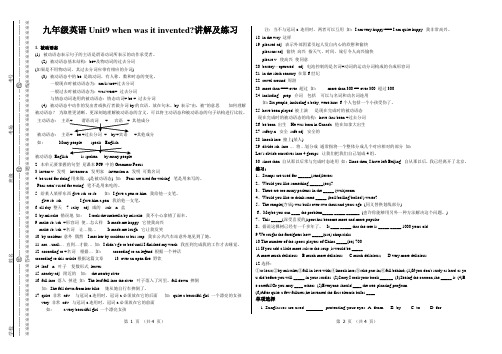
第 1 页 (共4 页) 第 2 页 (共4 页)学校 姓名 班级 考场 考号---------------------------------○密------------------ -------------------○封----------------------------- -- --○线----------------------------※※※※※※※※※※※※※※※答※※※※※※※※※※※※※※※※※※题※※※※※※※※※※※※※※※※线※※※※※※※※※※※※※九年级英语Unit9 when was it invented?讲解及练习1. 被动语态(1). 被动语态表示句子的主语是谓语动词所表示的动作承受者。
(2). 被动语态基本结构:be+及物动词的过去分词 (如果是不用物动词,其过去分词应带有相应的介词)(3). 被动语态中的be 是助动词,有人称、数和时态的变化。
一般现在时被动语态为:am/is/are+过去分词 一般过去时被动语态为:was/were+ 过去分词与情态动词连用的被动语态:情态动词+ be + 过去分词(4). 被动语态中动作的发出者或执行者做介词by 的宾语,放在句末,by 表示“由,被”的意思 如何理解被动语态? 为取胜更清晰、更深刻地理解被动语态的含义,可以将主动语态和被动语态的句子结构进行比较。
主动语态: 主语+ 谓语动词 + 宾语 + 其他成分被动语态: 主语+ be +过去分词 + by +宾语 +其他成分 如: Many people speak English.被动语态 English is spoken by many people. 2. 本单元要掌握的句型 见课本P69 中的Grammar Focus 3. invent v. 发明 inventor n. 发明家 invention n. 发明 可数名词4. be used for doing 用来做…(是被动语态) 如: Pens are used for writing. 笔是用来写的。
广东省珠海九中九年级英语全册《Unit 9 When was it inventedSection

Her face _w_a_s__n_o_ti_c_e_d__toturn red by us all.
4. The light bulb was invented by Tomas Edison. (对划线部分提问)
_y?
5. The refrigerator is used to keep food fresh. (改为同义句)
The refrigerator is usefdor__k_e_e_p_i_n_g__ food
fresh.
用合适的词填空。
1.We use the c_a_l_c_u_la_t_o_r_to count. The calculator_i_s_u_s_e_d_f_o_r_c_o_u_n_t_i_n_g_.
新目标 九年级 Unit 9
Unit 9 When was it invented?
Section A Period 2
Pairwork (3a:P70)
Helpful inventions: vacuum cleaner, soundproof door and window, car, computer, fax machine Annoying inventions: air-conditioner, truck, telephone, junk food, ice cream
when mother asks me to do the cleaning.
Dialogue 2: A: What do you think is the most
annoying invention? B: I think the most annoying invention
is the air-conditioner. A: Why is that?
九年级英语Unit_9_when_was_it_invented_知识点归纳
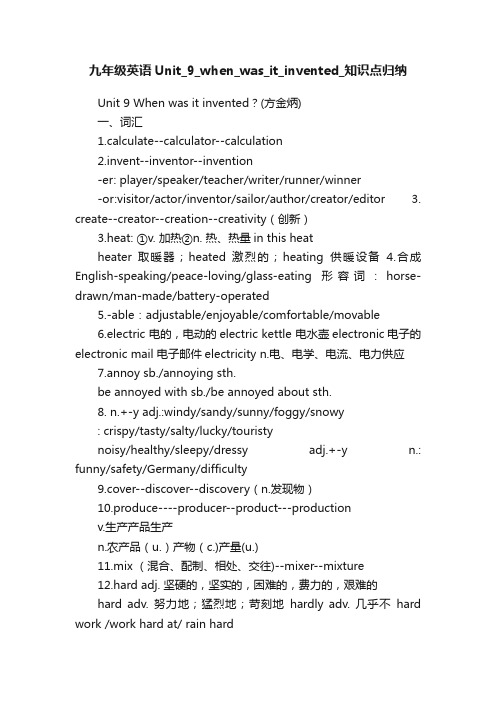
九年级英语Unit_9_when_was_it_invented_知识点归纳Unit 9 When was it invented?(方金炳)一、词汇1.calculate--calculator--calculation2.invent--inventor--invention-er: player/speaker/teacher/writer/runner/winner-or:visitor/actor/inventor/sailor/author/creator/editor 3. create--creator--creation--creativity(创新)3.heat: ①v. 加热②n. 热、热量in this heatheater 取暖器;heated 激烈的;heating供暖设备4.合成English-speaking/peace-loving/glass-eating 形容词:horse-drawn/man-made/battery-operated5.-able:adjustable/enjoyable/comfortable/movable6.electric 电的,电动的electric kettle 电水壶electronic电子的electronic mail 电子邮件electricity n.电、电学、电流、电力供应7.annoy sb./annoying sth.be annoyed with sb./be annoyed about sth.8. n.+-y adj.:windy/sandy/sunny/foggy/snowy: crispy/tasty/salty/lucky/touristynoisy/healthy/sleepy/dressy adj.+-y n.: funny/safety/Germany/difficulty9.cover--discover--discovery(n.发现物)10.produce----producer--product---productionv.生产产品生产n.农产品(u.)产物(c.)产量(u.)11.mix (混合、配制、相处、交往)--mixer--mixture12.hard adj. 坚硬的,坚实的,困难的,费力的,艰难的hard adv. 努力地;猛烈地;苛刻地hardly adv. 几乎不hard work /work hard at/ rain hard13.break “打碎、折断、损坏、破坏、违反(规定)打破(记录)broken “破碎的、灰心失望的”14.indoor adj.“户外的,室内的”outdoor adj. “户外的”Indoo rs adv. “在户内、在室内”outdoors adv。
广东省中山市九年级英语全册 Unit 9 When was it inve
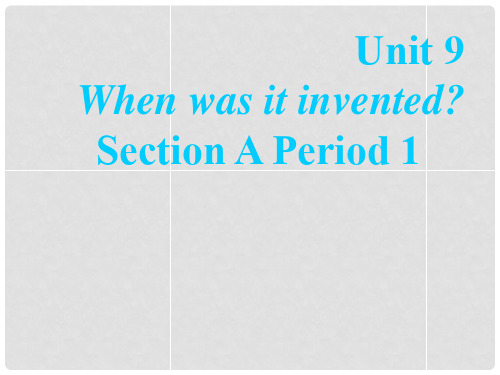
1876 EIGHTEEN SEVENTY-SIX
A: When was the telephone invented?
B: I think it was invented in 1876.
1885 eighteen eightyfive
A: When was the car invented? B: I think it was invented in 1885.
1976 nineteen seventy-six
A: When was the computer invented? B: I think it was invented in 1976.
Student A, say something about the picture in 30 seconds, and the first sentence must be “It was invented in……”.Student B, try to guess what it is.
eighteen seventy-six
Student A, please choose one of the numbers.
1 2 34 5
6 7 8 9 10
TV
nineteen twenty-seven 1927
computer
nineteen seventy-six 1976
calculator
_i_n_ve_n_tioonf sthe ancient China. They were ____ by Cmhoidneersne.wiTonrhvledey.nstteilldplay an important part in the
computer
广东地区九年级英语全册 Unit 9 When was it invented
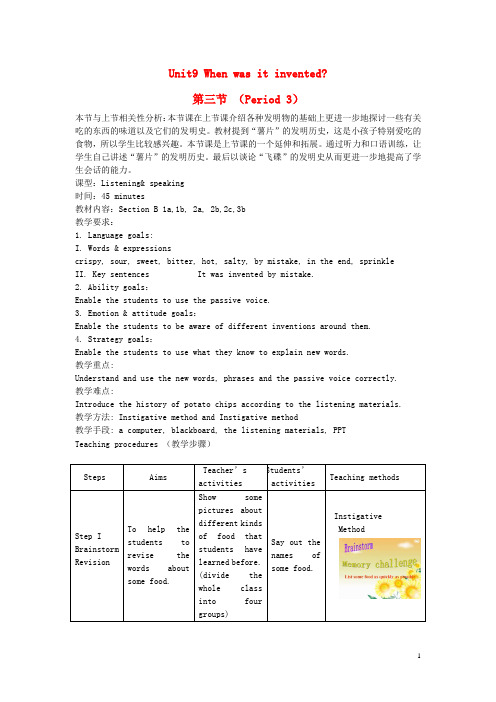
Unit9 When was it invented?第三节(Period 3)本节与上节相关性分析:本节课在上节课介绍各种发明物的基础上更进一步地探讨一些有关吃的东西的味道以及它们的发明史。
教材提到“薯片”的发明历史,这是小孩子特别爱吃的食物,所以学生比较感兴趣。
本节课是上节课的一个延伸和拓展。
通过听力和口语训练,让学生自己讲述“薯片”的发明历史。
最后以谈论“飞碟”的发明史从而更进一步地提高了学生会话的能力。
课型:Listening& speaking时间:45 minutes教材内容:Section B 1a,1b, 2a, 2b,2c,3b教学要求:1. Language goals:I. Words & expressionscrispy, sour, sweet, bitter, hot, salty, by mistake, in the end, sprinkleII. Key sentences It was invented by mistake.2. Ability goals:Enable the students to use the passive voice.3. Emotion & attitude goals:Enable the students to be aware of different inventions around them.4. Strategy goals:Enable the students to use what they know to explain new words.教学重点:Understand and use the new words, phrases and the passive voice correctly.教学难点:Introduce the history of potato chips according to the listening materials.教学方法: Instigative method and Instigative method教学手段: a computer, blackboard, the listening materials, PPTTeaching procedures (教学步骤)Steps AimsTeacher’sactivitiesStudents’activitiesTeaching methodsStep I Brainstorm Revision To help thestudents torevise thewords aboutsome food.Show somepictures aboutdifferent kindsof food thatstudents havelearned before.(divide thewhole classinto fourgroups)Say out thenames ofsome food.InstigativeMethodStep II Pairwork 1. To get thestudents totalk about thetastes ofdifferentfood.2. To get thestudents toknow theexpressions ofthe tastes.Give thestudents anexample:A: How thepotato chipstaste?B: It tastesvery tasty.then ask them towork in pairsand learn thewords: crispy,sour, sweet,bitter, hot,salty,Work inpairs.ElicitationmethodSlide 3,4,5,6,7&8Step III: Free talk To lead in thetargetlanguage.Ask thestudents somequestions aboutpotato chips.Talk witheach other.ElicitationmethodzStep IV:Listening practice To practice thestudents’listeningskills.Ask “How werethe potatochipsinvented?”Read theinstructions tothe class. Playthe recording.Check theanswers.Studentslisten andfinish 2a&2b.ElicitationmethodSep V: Speaking practice To practice thestudents’speakingskills.Ask thestudents torole play theconversationabout theinvention ofpotato chips.Work inpairsElicitationmethodStep VI: Extra speaking practice To practice thestudents’speakingskills.Lead thestudents tomakeconversationabout theinvention offlying disk.Work ingroupsaccordingto thelisteningmaterials.Inductive methodStep VII Exercise To help thestudents topractice whatthey learnedtoday.Show thestudents toexercise.Finish theexercise.Inductive andelicitation methodStep VIII Homework1.Retell the history of potato chips2. Write an article about the invention of the flying disk.附一:(Blackboard design)G1 G2 G3The emperor----was boiling----over…正正正Some leaves----fell into---remained…正正一The emperor noticed---produced…一教学反思:本节课是听说课。
广东省珠海九中九年级英语全册《Unit 9 When was it invented》教案 人教新目
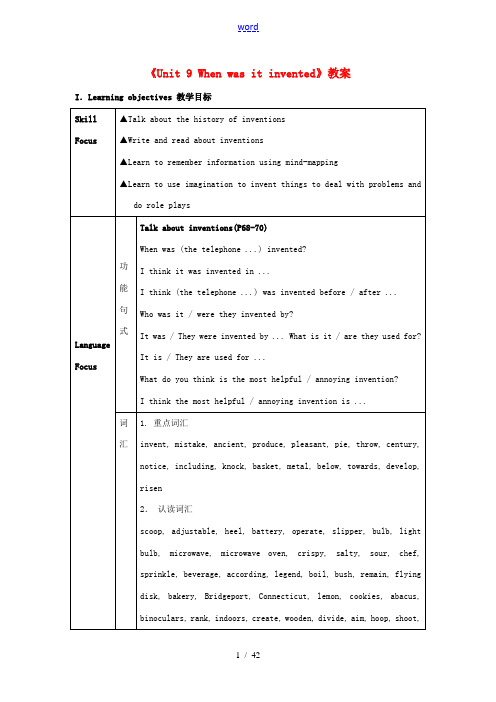
《Unit 9 When was it invented》教案I.Learning objectives 教学目标II. Teaching materials analyzing and rearranging 教材分析和重组1. 教材分析本单元以Inventions为话题,共设计了四个部分的内容:Section A该部分有4个模块:第一模块围绕When and in what order were they invented? 这一话题展开讨论(1a)、听力(1b)、口语(1c)训练;第二模块围绕3个inventions 进行听力(2a-2b)、口语(2c)训练;第三模块继续围绕inventions这一话题展开训练,要求列出两类不同的发明(3a)并以pairwork形式对此展开讨论和对话训练(3b);第四模块设置情景alone on a tiny island,以小组活动形式讨论在该情景下什么inventions重要及原因。
这部分主要训练口语、学生处理问题的思维能力和想象力。
Section B该部分有4个模块:第一模块是词汇的学习(1a)与运用(1b);第二模块围绕the historyof chips继续进行听力(2a-2b)、口语(2c)训练;第三模块围绕Who invented tea?这一话题展开阅读理解(3a),并要求学生能够以“From pie plate to flying disk”为题目进行应用写作训练(3b);第四模块以inventions这一话题训练学生的创造力、解决问题的能力和想象力(4a),并且以小组讨论和角色扮演(4b)的形式展开口语训练。
Self check该部分有2个模块:第一模块对所学词汇进行填空训练(1);第二模块要求就不同的inventions搜集信息并进行写作训练(2)。
Reading该部分共设置了5项任务:第一项任务以问题讨论的方式激活学生相关背景知识(Section 1);第二项任务要求学生通过快速阅读获取信息(Section 2);第三项任务利用填图、回答问题等练习形式进一步加深学生对阅读内容的理解(Section 3);第四项任务要求学生对“play on China’s national basketball team one day”问题发表观点、进行口语训练(Section 4);第五项任务要求学生对某一项发明进行调查研究。
广东省珠海九中九年级英语全册《Unit 9 When was it invented《Unit 9
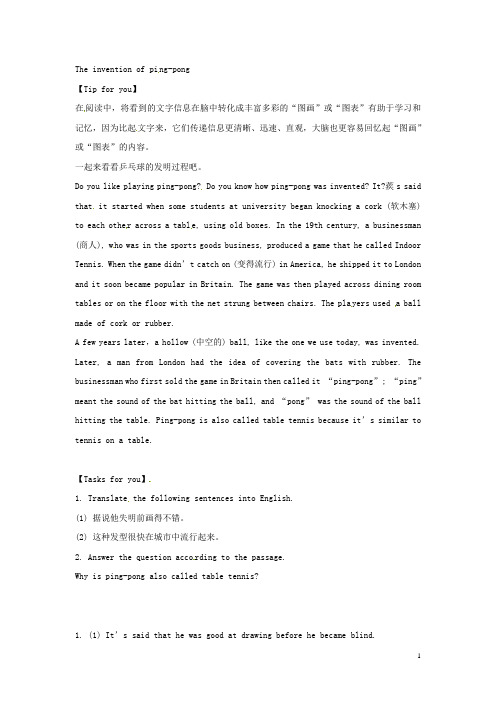
The invention of pi ng-pong【Tip for you】在阅读中,将看到的文字信息在脑中转化成丰富多彩的“图画”或“图表”有助于学习和记忆,因为比起文字来,它们传递信息更清晰、迅速、直观,大脑也更容易回忆起“图画”或“图表”的内容。
一起来看看乒乓球的发明过程吧。
Do you like playing ping-pong? Do you know how ping-pong was invented? It?蒺s said that it started when some students at university began knocking a cork (软木塞) to each othe r across a tabl e, using old boxes. In the 19th century, a businessman (商人), w ho was in the sports goods business, produced a game that he called Indoor Tennis. When the game didn’t catch on (变得流行) in America, he shipped it to London and it soon became popular in Britain. The game was then played across dining room tables or on the floor with the net strung between chairs. The pla yers used a ball made of cork or rubber.A few years later,a hollow (中空的) ball, like the one we use today, was invented. Later, a man from London had the idea of covering the bats with rubber. The businessman who first sold the game in Britain then called it “ping-pong”; “ping”meant the sound of the bat hitting the ball, and “pong” was the sound of the ball hitting the table. Ping-pong is also called table tennis because it’s similar to tennis on a table.【Tasks for you】1. Translate the following sentences into English.(1) 据说他失明前画得不错。
广东省珠海九中九年级英语全册《Unit 9 When was it invented-Kids In
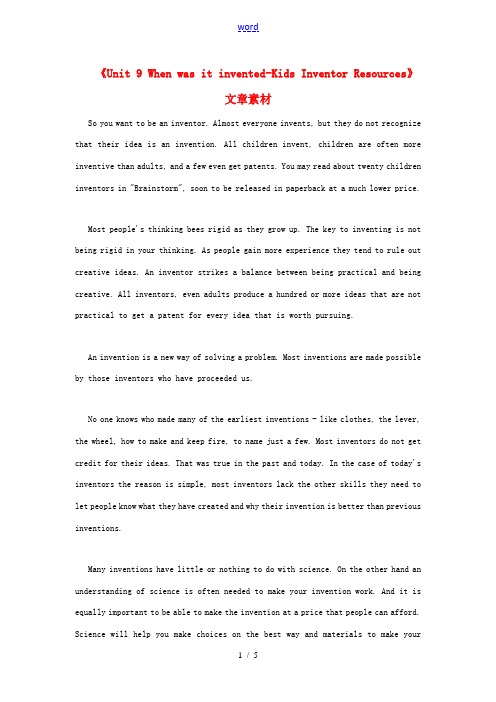
《Unit 9 When was it invented-Kids Inventor Resources》文章素材So you want to be an inventor. Almost everyone invents, but they do not recognize that their idea is an invention. All children invent, children are often more inventive than adults, and a few even get patents. You may read about twenty children inventors in "Brainstorm", soon to be released in paperback at a much lower price.Most people's thinking bees rigid as they grow up. The key to inventing is not being rigid in your thinking. As people gain more experience they tend to rule out creative ideas. An inventor strikes a balance between being practical and being creative. All inventors, even adults produce a hundred or more ideas that are not practical to get a patent for every idea that is worth pursuing.An invention is a new way of solving a problem. Most inventions are made possible by those inventors who have proceeded us.No one knows who made many of the earliest inventions - like clothes, the lever, the wheel, how to make and keep fire, to name just a few. Most inventors do not get credit for their ideas. That was true in the past and today. In the case of today's inventors the reason is simple, most inventors lack the other skills they need to let people know what they have created and why their invention is better than previous inventions.Many inventions have little or nothing to do with science. On the other hand an understanding of science is often needed to make your invention work. And it is equally important to be able to make the invention at a price that people can afford. Science will help you make choices on the best way and materials to make yourinvention.Understanding business is also important. Most inventors have to make and sell the invention themselves. Big established businesses are usually not interested in an invention until they see their customers buying from the inventor. A good book about selling your invention is Marketing Your Invention which is available from The Inventors Bookstore.You may be able to invent without understanding reading, writing, arithmetic, history and science. But you are NOT likely to PROFIT from inventing without all of those skills. You need to be able to read well to learn new skills. All the good ideas in the world are useless if you do not have the writing skills to be able to tell other people how and why your invention is valuable. You often need math to figure out how to make your invention and you always need math to figure out the cost to make and sell the invention. And you almost always need science to make the invention at the lowest cost.And history is also valuable. One of the reasons I am a successful inventor today is the lessons I learned from studying other inventors who proceeded me.I discuss who and why in detail in How I Learned to Bee a Successful Inventor, History Was The Key .Many middle school students have a drafting class. Drafting is a very important skill if you want to be an inventor. Basic drafting skills are important to help people understand your ideas.As a boy I loved science and math and I did not think I needed to write. I refused to do any more than absolutely necessary in English classes. Today I am an inventorand a writer. And I could not be a successful inventor if I could not write. I thought I knew it all, and I was WRONG-WRONG-WRONG.Don't be too eager to grow up. Most people like to teach children, but many of those same people will not want to teach you if they perceive you as grown up. So accept being a child, take advantage of it to learn as much as possible - about as many subjects as possible. Once you are an adult you will be expected to work, to pay your own way, and you will have much less opportunity to study.Both boys and girls invent. There is reason to believe that many the earliest inventions were made by women. There is little doubt that the first doctors were women. Early medicines and the methods to make clothing and to color the cloth were probably mostly invented by women. The bra was invented by a woman around the turn of the century. Some very successful inventions have been made by women in the last ten years. Chelsea Lanmon, the youngest female inventor that I am aware of is only nine years old (1997). Two recently deceased female inventors are Heddy Lamarr and Gertrude Belle Elion. It was my pleasure to have known Elion for five or six years before her death. She was a really nice lady who had a strong munity spirit. Her loss was especially touching.Most inventors today are male. At least nine out of ten inventors who receive patents are male. Why do males get more patents than females? I do not know the answer for sure, but I do not think it is because males are more inventive than females.One reason may be that fewer girls learn about math and science than boys and fewer girls make a real effort to learn about business. But the biggest reason may be that girls are less likely to aggressively defend their rights. It is my goalto see as many females receiving patents as males.All inventors are faced with a serious problem at some point in selling their invention. The problem is that if you produce a good invention someone is sure to act like a school yard bully and try to steal it from you.For some reason, being an inventor is like living in the west, when settling an argument often came down to who could draw their gun the fastest. I and many other inventors are working together to teach those panies who would steal inventor's work to be more honest and responsible.Starting in 1994 many professional inventors banded together to fight the panies who like to steal inventors work. Today the inventor alliance includes over two dozen Nobel laureates, most of the living National Inventors Hall of Fame inductees, and thousands of inventors.We are working to improve the protect inventors and to help inventors avoid the less honest panies. We are also creating programs to help educate young inventors. Those programs are aimed at teaching our "inventors to be" all the skills they need to start and run a business based on their inventions.There are two types of inventions that are important. The first is a breakthrough invention. Examples are the transistor, the integrated circuit, the laser, and the pacemaker. Another type of important invention is an improvement such as making something more safe, making it cheaper, or making it faster (less labor is the same as cheaper).An example of safer is my patents on treadmills. My oldest daughter was hurt on a treadmill in a Sears store. When I looked at how it worked I saw several things that made it unsafe, and it was especially unsafe for children because they do not weigh as much as a grownup. The solutions to those safety problems led to two patents.。
广东地区九年级英语全册 Unit 9 When was it invented

Unit 9 When was it invented?第一节(Period 1)课型:听说课时间: 45分钟教材内容:Section A 1a, 1b, 1c及Section B 4a教学目标:1. Language goals:I. Words & expressionsinvent, inventor, invention, be used for doing sth.II. Key sentencesWhen was the car invented? It was invented in 1885.Who was the telephone invented by? It was invented by Bell.What are they used for? They are used for seeing in the dark.2. Ability goals:Enable the students to use the passive voice.3. Emotion & attitude goals:Enable the students to get to know different inventions around them.4. Strategy goals:Enable the students to use what they know to explain new words.教学重点1.Key vocabulary: invent , calculator, be used for ( doing sth. )2.Talk about the history of inventions.When was the car invented? It was invented in 1885.Who was the telephone invented by? It was invented by Bell.What are they used for? They are used for seeing in the dark.3.To get to know passive voice.教学难点:Describe a new invention in English,including the time, the person and the usage.教学方法: Task-based teaching method教学手段: a computer, blackboard, the listening materials,PPTTeaching procedures (教学步骤)When was the telephone It was invented in 1876.BrainstormComputerWhat is the computer used for?It is used for surf ing the internetIt is used to surf the internet.steps aims activities activitiesTeaching aidsStep VII Invention show Tocultivatethestudents’creativity.1.Show aninventioncalled ababyfridgethat wasinventedby theteacherand talkabout itby usingthe targetlanguage.2.Ask thestudentsto designtheir owninventions.3.Show theclass somecreativeworks.Work in groupsto design theirinventions.1.Slide 16&17Name :_______________Inventor : ________________Date : ____________________Feature: ____________________(功能)Baby FridgeSabrina (C11,12)in November, 2009is used for keeping ice creamand food in the open air (在户外)___________________________2. Some pieces ofpaper, colorful pens.Step VIII Homework 1.Toconsolidatethecontentsthestudentshavelearnt.2.Tocultivatethestudents’writingskills.Try to finishthe writingaccording tothe demands.Write a shortinstruction(说明书) about oneor twoinventions inyour group.Introduce themto yourfriends.Slide 22附一:(Blackboard design)教学反思:新课程标准倡导任务型教学模式,即让学生在教师的指导下,通过感知、体验、实践、参与和合作等方式,实现目标,感受成功。
广东省珠海九中九年级英语全册《Unit 9 When was it i
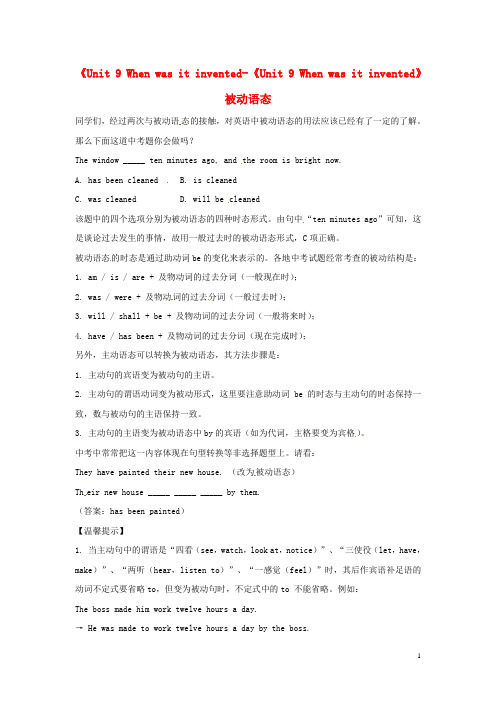
《Unit 9 When was it invented-《Unit 9 When was it invented》被动语态同学们,经过两次与被动语态的接触,对英语中被动语态的用法应该已经有了一定的了解。
那么下面这道中考题你会做吗?The window _____ ten minutes ago, and the room is bright now.A. has been cleanedB. is cleanedC. was cleanedD. will be cleaned该题中的四个选项分别为被动语态的四种时态形式。
由句中“ten minutes ago”可知,这是谈论过去发生的事情,故用一般过去时的被动语态形式,C项正确。
被动语态的时态是通过助动词be的变化来表示的。
各地中考试题经常考查的被动结构是:1. am / is / are + 及物动词的过去分词(一般现在时);2. was / were + 及物动词的过去分词(一般过去时);3. will / shall + be + 及物动词的过去分词(一般将来时);4. have / has been + 及物动词的过去分词(现在完成时);另外,主动语态可以转换为被动语态,其方法步骤是:1. 主动句的宾语变为被动句的主语。
2. 主动句的谓语动词变为被动形式,这里要注意助动词be的时态与主动句的时态保持一致,数与被动句的主语保持一致。
3. 主动句的主语变为被动语态中by的宾语(如为代词,主格要变为宾格)。
中考中常常把这一内容体现在句型转换等非选择题型上。
请看:They have painted their new house. (改为被动语态)Th eir new house _____ _____ _____ by them.(答案:has been painted)【温馨提示】1. 当主动句中的谓语是“四看(see,watch,look at,notice)”、“三使役(let,have,make)”、“两听(hear,listen to)”、“一感觉(feel)”时,其后作宾语补足语的动词不定式要省略to,但变为被动句时,不定式中的to 不能省略。
广东省珠海九中九年级英语全册《Unit 9 When was it i
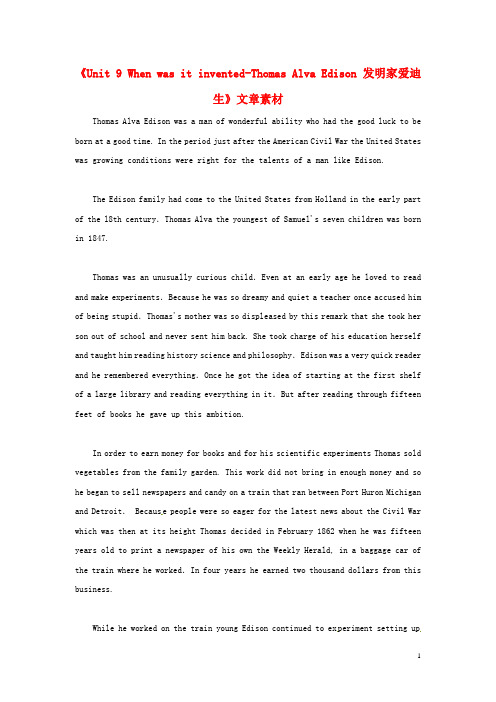
《Unit 9 When was it invented-Thomas Alva Edison 发明家爱迪生》文章素材Thomas Alva Edison was a man of wonderful ability who had the good luck to be born at a good time. In the period just after the American Civil War the United States was growing conditions were right for the talents of a man like Edison.The Edison family had come to the United States from Holland in the early part of the l8th century.Thomas Alva the youngest of Samuel's seven children was born in 1847.Thomas was an unusually curious child.Even at an early age he loved to read and make experiments.Because he was so dreamy and quiet a teacher once accused him of being stupid.Thomas's mother was so displeased by this remark that she took her son out of school and never sent him back. She took charge of his education herself and taught him reading history science and philosophy.Edison was a very quick reader and he remembered everything.Once he got the idea of starting at the first shelf of a large library and reading everything in it.But after reading through fifteen feet of books he gave up this ambition.In order to earn money for books and for his scientific experiments Thomas sold vegetables from the family garden. This work did not bring in enough money and so he began to sell newspapers and candy on a train that ran between Port Huron Michigan and Detroit. Becaus e people were so eager for the latest news about the Civil War which was then at its height Thomas decided in February 1862 when he was fifteen years old to print a newspaper of his own the Weekly Herald, in a baggage car of the train where he worked.In four years he earned two thousand dollars from this business.While he worked on the train young Edison continued to ex periment setting upa laboratory in the baggage car. One day a stick of phosphorus feIl to the floor and set the car on fire. The conductor of the train as so angry that he threw Tom and all his equipment off the train at the next station; he also struck Tom causing a permanent injury which later made him deaf in the right ear.One day not long after he had started his newspaper, Edison saw a child playing on the tracks in front of a train. He jumped off the station platform and snatched the child from the wheels of the train. The father who happened to be the stationmaster was so grateful that he offered to teach Tom to become a telegraph operator.He gave him lessons four days a week after the station had closed for the night and in three weeks Edison was a better telegrapher than his teacher.Edison was sober and independent for his age, but hen was restless and very careless in his dress. He began to wander from city to city and from job to job. Because his ideas were too strange to please the men who hired him, they often asked him to leave. During this time, he worked in Indianapolis, Cincinnati, Memphis, and Louisville.Edison went to Boston's where he had been promised work as operator, mainly because of the neat handwriting in his letter of application, When he appeared in that city, he looked so untidy and strange that the superintendent asked him to return later in the day to take a test in telegraphy, with the idea of making the test so difficult that the young man could not possibly pass it, As the rapid message came in, Edi son realized clerks in the station were playing a joke on him. They had arranged for the new York operator to send him a message, faster and faster, in an effort to make Edison admit that he could not write it down at such a rapid pace, But Edison was not discourag ed. He decided to outwit these fellows, and he began to send a message himself. He said to the New York operator,“Come on, don't go to sleep.Get busy! That ended the joke, and Edison won his job, as well as the title of fastest telegraph operator in the Western Union Company.In 1869 he borrowed some money and went to New York. During the first three years he spent there, he nearly died of starvation. He slept in a room belonging to a company that sent information on stock prices to the business houses of New York. One day the machine that printed news about gold stop ped.Six hundred banks and business houses were without information about what was being bought and sold that day. Edison succeeded in repairing the machine, and he was then offered a job as manager for $300 a month.He was soon hard at work making improvements in the machine and inventing new parts.His Un iversal Printer, invented at this time, printed full information about gold prices, instead of showing them only by a few letters and numbers. This was his first big success.GeneraI Marshall Lefferts, president of the Gold and Stock Telegraph Company, bought this and several other inventions of Edison's for forty thousand dollars.Edison then put his new money to work.He opened a factory in Newark, New Jersey. Soon he had over one hundred and fifty men building machines to record stock prices, while he himself continued to work on new ideas. At one time, he had forty-five separate inventions in his laboratory, including several important improvements of the telegraph. He invented a way of sending two messages at the same time in opposite directions, and then a way of sending two messages at the same time in the same direction, In 1874 he invented and sold to Western Union a system by which four messages could be sent over one wire at the same time, two in each direction. He also perfected a new system for sending telegrams. These inventions saved Western Union millions of dollars in the cost of wires and telegraph poles alone.Western Union then suggested to Edison that he try to develop a commercially useful telephone, Alexander Graham Bell had already patented the te1ephone, but Bell's telephone could be heard only over short distances. Edison added several improvements, which were adopted, and are still used in the telephone today. Western Union paid Edison one hundred thousand dollars for his inventions.In l876 he built a workshop and laboratory in Menlo Park, New Jersey.He was known after that as he Wizard of Menlo Park, because of the wonderful discoveries he made there, He began to study the attempts of other men to invent an incandescent electric light. He tried over and over again to make a soft light that would be suitab1e for use in private houses. He tested over two thousand materials before discovering one that would work. He needed something that would become hot and give off light when electricity passed through it in a g lass container from which the air had been removed. He spent a hundred thousand dollars searching for the best material. Men were sent to India, China, Brazil, and finally, Japan, where a material was finally found.In January,1880, the electric light was patented. Edison then built a factory for the production of his light in Menlo Park, and an electric power station in New York City. But it was fourteen years before the public really accepted the electric light. After that, the electric light business grew So great that Edison was able to sell his share in the electric light for more than one million dollars.Edison patented over one thousand separate inventions during his life, He never stopped trying to learn more about science and what it could do for man, His discoveries probably increased the wealth of the world more than those of any other single man in history.On October l8,1931,Edison died at the age of eighty-four at his home in Orange, New Jersey. Several days later, the whole United States turned off its electric lights for one minute, in honor of the man whose discoveries had so changed a nd improved the life of people everywhere.托马斯.阿尔法.爱迪生是一位诞生在好时代里的天才人物。
广东省珠海九中九年级英语全册《Unit 9 When was it invented-Fascina
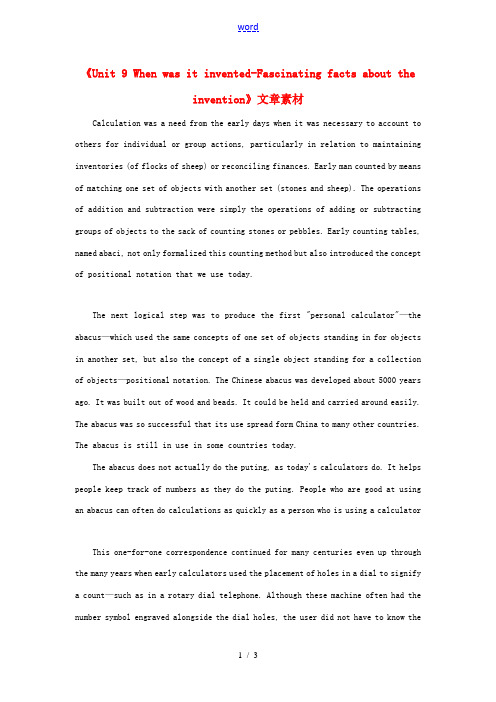
《Unit 9 When was it invented-Fascinating facts about theinvention》文章素材Calculation was a need from the early days when it was necessary to account to others for individual or group actions, particularly in relation to maintaining inventories (of flocks of sheep) or reconciling finances. Early man counted by means of matching one set of objects with another set (stones and sheep). The operations of addition and subtraction were simply the operations of adding or subtracting groups of objects to the sack of counting stones or pebbles. Early counting tables, named abaci, not only formalized this counting method but also introduced the concept of positional notation that we use today.The next logical step was to produce the first "personal calculator"—the abacus—which used the same concepts of one set of objects standing in for objects in another set, but also the concept of a single object standing for a collection of objects—positional notation. The Chinese abacus was developed about 5000 years ago. It was built out of wood and beads. It could be held and carried around easily. The abacus was so successful that its use spread form China to many other countries. The abacus is still in use in some countries today.The abacus does not actually do the puting, as today's calculators do. It helps people keep track of numbers as they do the puting. People who are good at using an abacus can often do calculations as quickly as a person who is using a calculatorThis one-for-one correspondence continued for many centuries even up through the many years when early calculators used the placement of holes in a dial to signify a count—such as in a rotary dial telephone. Although these machine often had the number symbol engraved alongside the dial holes, the user did not have to know therelationship between the symbols and their numeric value.Primitive people also needed a way to calculate and store information for future use. To keep track of the number of animals killed, they collected small rocks and pebbles in a pile. Each stone stood for one animal. Later they scratched notches and symbols in stone or wood to record and store information. Only when the process of counting and arithmetic became a more abstract process and different sizes of groups were given a symbolic representation so that the results could be written on a "storage medium" such as papyrus or clay did the process of calculation bee a process of symbol manipulation.AT A GLANCE:Invention: abacus in c3000 BCabacus / noun .Function: A counting device: a mechanical device for making calculations consisting of a frame mounted with rods along which beads or balls are movedNationality: ChineseMilestones:3000 BC - The abacus, built out of wood and beads, used the concepts of one set of objects standing in for objects in another set, but also the concept of a single object standing for a collection of objects—positional notation.- Earlytables, named abaci, formalized counting and introduced the concept of positional notation.- Early man counted by means of matching one set of objects with another set (stones and sheep).invention, history, inventor of, history of, who invented, invention of, fascinatingfacts.。
- 1、下载文档前请自行甄别文档内容的完整性,平台不提供额外的编辑、内容补充、找答案等附加服务。
- 2、"仅部分预览"的文档,不可在线预览部分如存在完整性等问题,可反馈申请退款(可完整预览的文档不适用该条件!)。
- 3、如文档侵犯您的权益,请联系客服反馈,我们会尽快为您处理(人工客服工作时间:9:00-18:30)。
课题:书法---写字基本知识课型:新授课教学目标:1、初步掌握书写的姿势,了解钢笔书写的特点。
2、了解我国书法发展的历史。
3、掌握基本笔画的书写特点。
重点:基本笔画的书写。
难点:运笔的技法。
教学过程:一、了解书法的发展史及字体的分类:1、介绍我国书法的发展的历史。
2、介绍基本书体:颜、柳、赵、欧体,分类出示范本,边欣赏边讲解。
二、讲解书写的基本知识和要求:1、书写姿势:做到“三个一”:一拳、一尺、一寸(师及时指正)2、了解钢笔的性能:笔头富有弹性;选择出水顺畅的钢笔;及时地清洗钢笔;选择易溶解的钢笔墨水,一般要固定使用,不能参合使用。
换用墨水时,要清洗干净;不能将钢笔摔到地上,以免笔头折断。
三、基本笔画书写1、基本笔画包括:横、撇、竖、捺、点等。
2、教师边书写边讲解。
3、学生练习,教师指导。
(姿势正确)4、运笔的技法:起笔按,后稍提笔,在运笔的过程中要求做到平稳、流畅,末尾处回锋收笔或轻轻提笔,一个笔画的书写要求一气呵成。
在运笔中靠指力的轻重达到笔画粗细变化的效果,以求字的美观、大气。
5、学生练习,教师指导。
(发现问题及时指正)四、作业:完成一张基本笔画的练习。
板书设计:写字基本知识、一拳、一尺、一寸我的思考:通过导入让学生了解我国悠久的历史文化,激发学生学习兴趣。
这是书写的起步,让学生了解书写工具及保养的基本常识。
基本笔画书写是整个字书写的基础,必须认真书写。
课后反思:学生书写的姿势还有待进一步提高,要加强训练,基本笔画也要加强训练。
课题:书写练习1课型:新授课教学目标:1、教会学生正确书写“杏花春雨江南”6个字。
2、使学生理解“杏花春雨江南”的意思,并用钢笔写出符合要求的的字。
重点:正确书写6个字。
难点:注意字的结构和笔画的书写。
教学过程:一、小结课堂内容,评价上次作业。
二、讲解新课:1、检查学生书写姿势和执笔动作(要求做到“三个一”)。
2、书写方法是:写一个字看一眼黑板。
(老师读,学生读,加深理解。
)3、书写教学“杏花春雨江南”6个字。
杏:上大下小,上面要写得大,大在哪里?(大在撇捺)写的时候撇捺要舒展,象燕子张开的翅膀;下面的“口”要写得小,左右两竖要内斜,稍扁;“木”的竖写在竖中线上。
花:也是上下结构,草字头两竖要内斜;下面单人旁起笔对准上面的左竖,竖弯钩起笔对准上面的右竖;竖弯钩要舒展,(用红笔描竖弯钩,并在旁边书写一个大的竖弯钩)要求弯处圆转,不能僵硬(书写僵硬的竖弯钩,并在旁边打×)。
春:上部三横都是短横,收笔处不要顿;撇画最长,捺画从哪里起笔?从第三横下面起笔,不能碰到撇;下面“日”的两竖要竖直,不能斜。
雨:旁边两竖要内斜,上横短,中竖写在竖中线上;从下面看,哪一笔最低?钩最低,中竖最短;四个点都是斜点。
江:左右结构,左窄右宽左边三点水第二点略向外展;右边“工”字上横是短横,下横是长横;中竖略斜。
南:上横短;下边两竖内斜;框架中两横都是短的,中间一竖悬针;三个竖画左、中差不多长,右竖钩最低;横折钩要写出弯势。
4、学生练习,教师巡回指导。
三、讲评:收上学生的作业,进行批改和评比,对写得好的进行表扬,并加盖☆符号章,然后贴在展示板上,向学生展示。
板书设计:书写练习1、杏花春雨江南我的思考:进一步加强写字姿势训练,这是根本。
在了解字结构的基础上更好的把握每个字的书写。
及时对书写情况进行反馈,同时通过奖励激发学生兴趣。
课后反思:通过字形的比较,学生基本上学会了笔画位置的比较,但是还需要不断的引导。
第(3)课时课题:书写练习2课型:新授课教学目标:1、掌握车字旁写法,并能把“轻”字写端正。
2、完成书写练习。
重点:正确地书写“轻”字难点:“车”字旁的书写。
教学过程:一、讲评上一课作业情况。
1、表扬书写优秀者,展示其作业。
2、指出存在的主要缺点并进行针对性的练习。
二、指导“车”字旁写法:1、出示范字,观察“车”字旁写法。
2、讨论明确其书写要领:“车”字旁分四笔完成,整个偏旁左重右轻,不超过竖中线。
第一笔横稍短。
第二笔撇折收笔于横中线。
第三笔垂露竖,应在第一笔横下的正中位置起笔。
最后一笔,比第一横长一些,离折笔稍近一些。
3、练写“车”字旁。
三、指导临写“轻”字。
1、观察范字。
2、明确写法。
“轻”字的写法:“轻”字左窄右宽,右边的第一笔起笔与左边的第一笔短横相齐平,底部大体相齐,右边上下两部分基本相等。
四、课后延伸书写:斩、转板书设计:书写练习2、轻、斩、转我的思考:以复习巩固导入,并有针对地进行纠正。
明确字的重心及每个笔画在田字格中分布的位置,使学生初步掌握字的结构特点。
在练习书写“车”字旁的基础上,更好的把握整个字的字形。
课后及时巩固,拓展。
课后反思:学生基本上能把握好字在田字格中的位置,处理好左右的布局。
第(4)课时课题:结构特点(六)课型:新授课教学目标: 1、懂得以宝盖头、穴字头等作为字头的字宜上大而下小。
2、通过练习,写好课文中的例字。
重点:掌握以宝盖头、穴字头等作为字头的字宜上大而下小难点:把握好字的结构。
教学过程:一、复习巩固二、教学新课1.讲解以宝盖头、穴字头等作为字头的字(1)教师讲解字头的书写。
(2)学生练习书写,教师指导书写。
(3教师根据实际情况小结,提出要求。
2.指导书写例字(1)出示例字:“宝”:首先要控制好字头,摆正位置,下面的“玉”字占格子的一半以上,特别是最后一横宜稍长,使整个字立正。
“穷”:下面的力字宜正,不宜写得太小。
(其余字略)(2)学生练习,师巡回指导。
3、提出注意点三、讲评:收上学生的作业,进行批改和评比,对写得好的进行表扬,并加盖☆符号章,然后贴在展示板上,向学生展示。
板书设计:结构特点(6)宝、穷、写、会、奔我的思考:使学生更好的把握好字的结构,同时在教师的指导下提高学生辨别能力。
激励学生更好的书写。
第(5)课时课题:怎样写好字课型:复习课教学目标:1、让学生能够正确认识,端正态度。
教学过程:一、正确的学书之路1.临帖临帖是学习书法的最根本的方法。
古往今来,没有一个书法家是不经临习而成功的,没有一个字写得好的人是不经过临帖的。
只有临帖,取法唐楷、晋行、汉隶、秦篆等传统的东西,才会有所获。
2.专一学书首先应师承一家,建立根据地,然后再发展。
这就有一个选帖的问题,选帖的标准:①好帖;②喜欢。
选定帖后专心致志,认真临习,坚持不懈,直至形同神似。
这个时期检验你学习得怎样,首先看临得像不像,再看笔法笔意。
3.博采众长当对一本帖或一家书体临习达到形同神似之后,就要广涉其他好帖,取其营养加以吸收消化,融会贯通。
4.字外功夫练字的同时经常要多读书,多掌握方方面面的知识,加强自身修养。
总之一句话,加强字外功夫的训练。
在此基础上,逐步形成自己的风格,便自成一家。
综上所述,我们可以把正确的学书之路概括为:二、科学的学书方法明确了正确的学书之路之后,我们还要掌握科学的学习方法,有了科学的学习方法,就可得到较好的学习效果。
1.临帖和摹帖这既是正确学书之路的开端,又是正确学书方法中的根本点,必须坚信不疑,坚定不移。
摹帖和临帖各有优点,效果各异。
姜夔《续书谱》中说:“临书易失占人位置,而多得古人笔意,摹书易得古人位置,而多失古人笔意,临书易进,摹书易忘。
”其中的“笔意”即指笔法、笔势及线条意趣。
“临”的方法就是看着字帖,照着写。
只要仔细地临,便容易掌握笔法笔意.从而把范本的精髓学到手。
“摹”的方法,就是用薄纸蒙在帖上,直接地描画。
所以字形基本上不会走样,多摹几遍,有利于把握结构。
但摹书看不清笔法,“易失笔意”,虽然间架不错.但没有笔法,字就僵化。
所以,初学者可以临摹并用,相互补充。
2.每天定量事实证明,任何事情都有一个由量变到质变的过程,练字也一样,写得太少,练习量跟不上,就谈不上进步;当然盲目机械地多写,疲倦了效果也不好。
一定的量才能达到的一定的效果,较佳的量才能达到较佳的效果。
3.循序渐进学习书法,在勤学苦练的基础上,还应该懂得它是一个循序渐进的过程:第一,先正楷,后行草。
苏轼说:“真生行,行生草。
真如立,行如行,草如走。
”就是说楷、行、草书三者如同人的立、走、跑,如果人连站都不能站,怎么能走和跑呢?如果没有楷书基础,直接写行书、草书,就会疏于法度,流于轻滑飘浮。
行书、草书是楷书的流、便、疏、散,学好楷书之后,加强用笔的流动呼应,行草就容易上手。
等到楷法熟练,再写行草时.便可悟到两者相通之处,可相辅相成,互相促进,相得益彰。
第三,先点画,后结构,再章法。
书法是线条的艺术,也就是以基本点画为基础的艺术。
基本点画不好,整字或整篇的艺术性就无从谈起。
由于钢笔尖性硬,在线条变化上相对简单得多,故钢笔书法学习在结构上花的时间多,而在用笔、点画上相对较少。
但这并不是说点画用笔不重要,相反,它是钢笔书法的基本功,只有在点画书写的基本功扎实之后,才可能去把握结构。
在结构上有了一定的基础后,整幅字的章法就容易把握了。
第(6)课时课题:结构特点(七)课型:新授课教学目标:1、了解“皿”、“土”等做字底的字的结构特点,学习这类字的写法。
2、通过练习,写好课文中的例字。
重点:掌握字的结构,学习写法。
教学过程:一、观察例字,进行讨论:(1)这些字是什么结构?(2)它们分别是什么字底?(3)书写上有什么特点?二、教师示范小结三、指导要点盘:上半部分宜瘦长,下面要宽扁。
皇:“白”字头是方形结构的,要写的紧凑些,略小;“王”上两横短,下横长,略大。
至:第一横不要太斜,撇折点也不要太斜;下面的“土”要端正,下横要长。
竖:上半部分要摆好位置,左右不要分开;下面的“立”,点在正中,上横短,点撇要呼应,下横适当拉长。
四、学生练习,教师指导。
五、收上学生的作业,进行批改和评比,对写得好的进行表扬,并加盖☆符号章,然后贴在展示板上,向学生展示。
板书设计:结构特点(七)、盘至竖我的思考:通过自主观察来了解字形。
在逐字的教学指导中使学生学会自主分析,养成良好的学习习惯。
课后反思:部分学生在练习中还需要指导。
第(7)课时课题:结构特点(八)课型:新授课教学目标:1、了解上下相同、左右相同这类字的结构特点,学习这类字的写法。
2、通过练习,写好课文中的例字。
重点:掌握这类字的结构,学习写法。
教学过程:一、例字,再说说它们有什么共同的特点。
二、读课文中的一段话,说说这段话的意思。
三、教师示范并小结。
四、范字指导提要哥:下面的部分要先写“口”再写竖钩,注意笔顺。
竹:左竖回锋,有撇略高于和长于左撇。
羽:左小右大,其中的4点要摆好位置,使其显得丰满些。
吕、昌:口和曰要写成扁方形,上下重复,上小下大。
兢:语文课文中还没有出现过,这个字可只让学生知道其书写方法,左边的竖弯钩改成竖提。
五、收上学生的作业,进行批改和评比,对写得好的进行表扬,并加盖☆符号章,然后贴在展示板上,向学生展示。
